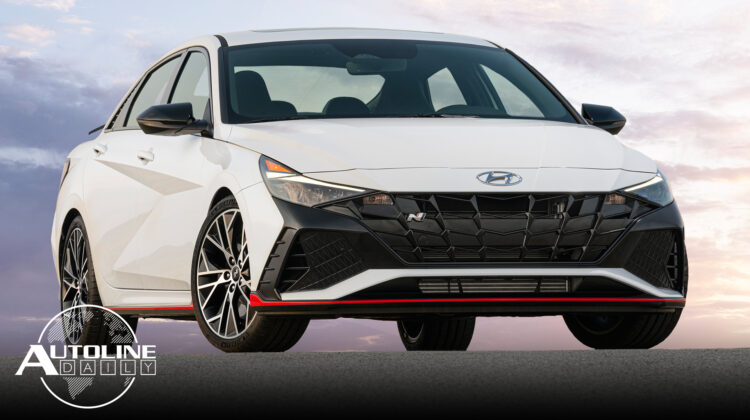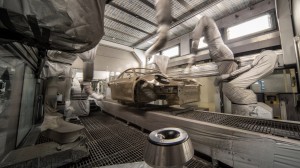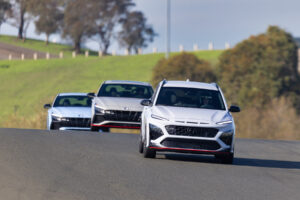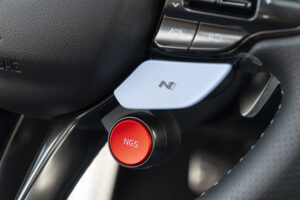
Listen to “AD #3290 – Hyundai N Cars a Blast to Drive; Tesla Wants to Split Its Stock; NHTSA Boosts Fuel Economy Fines” on Spreaker.
Follow us on social media:
Runtime: 11:40
0:08 Russia Threatening to Confiscate Car Plants
0:54 CATL Claims New Battery Has More Capacity Than 4680 Battery
1:44 Tesla Wants to Split Its Stock
2:13 Tesla Suspends Production in Shanghai
3:16 Electric Trucks Always Going to Cost More Than ICE Trucks
4:19 Porsche Opens New Paint Shop
5:21 Hyundai N Cars a Blast to Drive
9:09 NHTSA Boosts Fuel Economy Fines
9:57 Mercedes Makes Most Profit Per Vehicle
Visit our sponsors to thank them for their support of Autoline Daily: Bridgestone, Intrepid Control Systems and Schaeffler.
This is Autoline Daily, the show dedicated to enthusiasts of the global automotive industry.
RUSSIA THREATENING TO CONFISCATE CAR PLANTS
Russia Is threatening to confiscate the assembly plants of car companies that have suspended production in the country. Right now, it’s asking the OEMs to clarify what their future plans are. It expects some automakers will leave the market forever and said it’s considering nationalizing their operations. According to WardsAuto, most European and some Japanese companies, including Renault, Daimler, BMW and Toyota, are at the greatest risk of a government takeover. But some Chinese and South Korean companies plan to stay. Right now, the shutdowns in Russia will cost automakers an estimated 13 billion euros this year.
CATL CLAIMS NEW BATTERY HAS MORE CAPACITY THAN 4680 BATTERIES
Move over Tesla, Chinese battery maker CATL says it has the best battery in the world. It just introduced its third-generation cell-to-pack battery technology, and claims it now has the world’s best system weight, gravimetric energy density and volumetric energy density. CATL says its cell capacity is 13% more than Tesla’s 4680 cells, even though it’s using the same chemistry and battery pack size. The cell-to-pack technology is available with LFP or NCM batteries. The NCM batteries have a range up to 1,000 kilometers or about 620 miles and go into production in 2023.
TESLA WANTS TO SPLIT ITS STOCK
Speaking of Tesla, if you own its stock, you’re about to make a lot more money. The company announced it’s seeking shareholder approval for a stock split. Tesla wants to increase the number of shares and give that to shareholders as a dividend. Tesla last did a five-for-one split in August 2020 and since that time, the stock surged 128% to over $1,000 a share.
TESLA SUSPENDS PRODUCTION IN SHANGHAI
But here’s something that could put a damper on the share price for now. Tesla is once again suspending production at its Shanghai factory because of COVID lockdowns. It’s idling production for four days while city official’s lockdown the city in two stages to carry out tests over the next nine days. China, as you know, follows a super strict, anti-Covid policy that can force millions of people to stay home. Tesla had to suspend production at the factory for two days earlier this month for the same reason. It produces about 2,000 vehicles a day on average at that plant, so the lost production can add up quick.
ELECTRIC TRUCKS ALWAYS GOING TO COST MORE THAN ICE TRUCKS
Daimler truck’s CEO says electric trucks and buses are always going to cost more than their ICE counterparts. Martin Daum says it costs Daimler 25,000 euros for the engine, transmission and fuel and cooling systems in a diesel truck. And he says even if battery costs fall to only 60 euros per kilowatt hour it will still cost 24,000 euros for just the battery in an electric truck. That’s based on a 400-kWh pack, which likely returns a similar range as the diesel truck. Last year the cost for batteries in heavy trucks was 120 euros or $132 per kWh. And with Russia’s invasion of Ukraine material prices are only going higher. Martin Daum says Daimler Truck could put more focus on fuel cells since they don’t need the rare materials needed in batteries and they wouldn’t have to compete with car companies to get them.
PORSCHE OPENS NEW PAINT SHOP
The paint shop is the most expensive area of any assembly plant. It can cost hundreds of millions of dollars. And painting a vehicle is one of, if not THE, most critical parts of the assembly process. You need all kinds of special machines, everything has to stay extremely clean and do it all while curbing the amount of emissions going into the air. Otherwise it shows up in the final product and paint is one of the first things a customer sees. That’s why Porsche’s investment in a new paint shop is so important. It added an additional color mixing bank, which allowed it to increase its list of pre-approved paint options to 160. And now it doesn’t have to slow production to add in a special color. Before it was able to paint 5 cars a day, but now it can do 20, which is 120 per week. And that will help Porsche meet the growing demand for its vehicles.
HYUNDAI N CARS A BLAST TO DRIVE
Hyundai has been on a product tear lately, coming out with all kinds of new models. But this year there’s a bit of lull in the action. So it’s concentrating on promoting its N and N Line performance line-up, which includes the Elantra, Veloster and Kona. A quick explanation. N is the high-performance version of these cars, while the N Line is a step down from that. The N Line gets you all the trim pieces, but not all the performance bits. Roughly speaking, the N-line adds about $4,400 to the base model, while the N adds about $7,500 on top of that. The Elantra N, for example, is just under $32,000.
Here’s what you get when you step up to the N: a 2-liter turbo that cranks out 276 horsepower and 289 pound feet. That’s 81 horsepower and 94 more foot pounds more than what you get with the 1.6-liter turbo that’s available in the N Line. You also get the choice of an 8-speed DCT or a 6-speed manual with rev matching. An electronic limited slip differential helps you put down the power when you need it. And there’s two cool electronic features you wouldn’t expect to find in a car of this class. One is launch control to help get you off the line as fast as possible. The other is what Hyundai calls Grin Shift. Push the red button on the steering wheel of the Elantra or Kona and you get 20 seconds of overboost which adds another 10 horsepower. It’s kind of like the “push-to-pass” button that they use in IndyCar.
The N cars also get bigger brakes. The front 14.2 inch rotors are over three inches larger than on the N Line, while the rear 12.4 inch rotors are over 2 inches bigger. And you get a choice of Michelin Pilot Sport + S or Pirelli P Zeros which are mounted on 19 x 8 inch wheels.
To enhance the handling, the Elantra features a cross frame bar in the rear that increases torsional stiffness by 29%, and steel rings on the tops of the front struts to add more rigidity.
Inside, well bolstered bucket seats keep you firmly in place. And there’s a 12.25-inch cluster on the center console that will even display performance data.
The N cars are a blast to drive. While they’re quick, their real forte is in the chassis dynamics. They handle well, are quite predictable, and easy to hustle around an autocross or lap a track. Hyundai is out to conquest customers with these cars. It’s targeting people who would otherwise consider a Golf GTi, a Honda Civic Si or a Subaru WRX. Those are iconic names in the hot hatch segment but Hyundai believes it has the hardware to take them on.
NHTSA BOOSTS MPG FINES
Here’s another incentive to get automakers in the U.S. to speed up their transition to electric vehicles. NHTSA is boosting the penalties that automakers have to pay for missing fuel economy targets. The fine was $5.50 for every tenth of an MPG that they miss the target multiplied by every vehicle sold. For the last two years, it jumped to $14 and now it’s going to $15 for 2022 model year vehicles and beyond. The penalties were set under the Obama Administration but were delayed during Trump’s time in office. NHTSA estimates the fines for 2019 model year vehicles will total $294 million.
MERCEDES MAKES MOST PROFIT PER VEHICLE
We’ve been comparing the top automakers in the world according to who sold the most cars, who brought in the most revenue, and who posted the highest profits. Now let’s look at which automaker made the most profit on every vehicle it sold. And Mercedes-Benz tops the list at nearly $6,000. But look at who’s in second place. Tesla. We think that it will pass Mercedes sometime this year. BMW is not that far behind Tesla, and then there’s a drop to Ford and Stellantis. Surprisingly, Volkswagen and Toyota are in the 6th and 7th spots. We thought their economy of scale would make them more profitable. General Motors is in 8th place and it’s probably so far down the list because it sells a lot of low-margin cars in South America and China. Honda is in 9th place, and it’s surprising to see that Hyundai only makes a profit of $703 on each car it sells.
| TOP 10 OEMs BY PROFIT PER UNIT 2021 | |
|---|---|
| 1. Mercedes-Benz | $5,909 |
| 2. Tesla | $5,895 |
| 3. BMW | $5,447 |
| 4. Ford | $2,463 |
| 5. Stellantis | $2,372 |
| 6. VW Group | $1,914 |
| 7. Toyota | $1,839 |
| 8. General Motors | $1,581 |
| 9. Honda | $1,197 |
| 10. Hyundai | $703 |
| Source: Annual Reports | |
If you like this information, we did a video on it that has a lot more analysis, and you can check it out on our YouTube channel, or look for the link in today’s transcript.
But that’s it for today, thanks for watching.
Thanks to our partner for embedding Autoline Daily on its website: WardsAuto.com
Seamus and Sean McElroy cover the latest news in the automotive industry for Autoline Daily.










